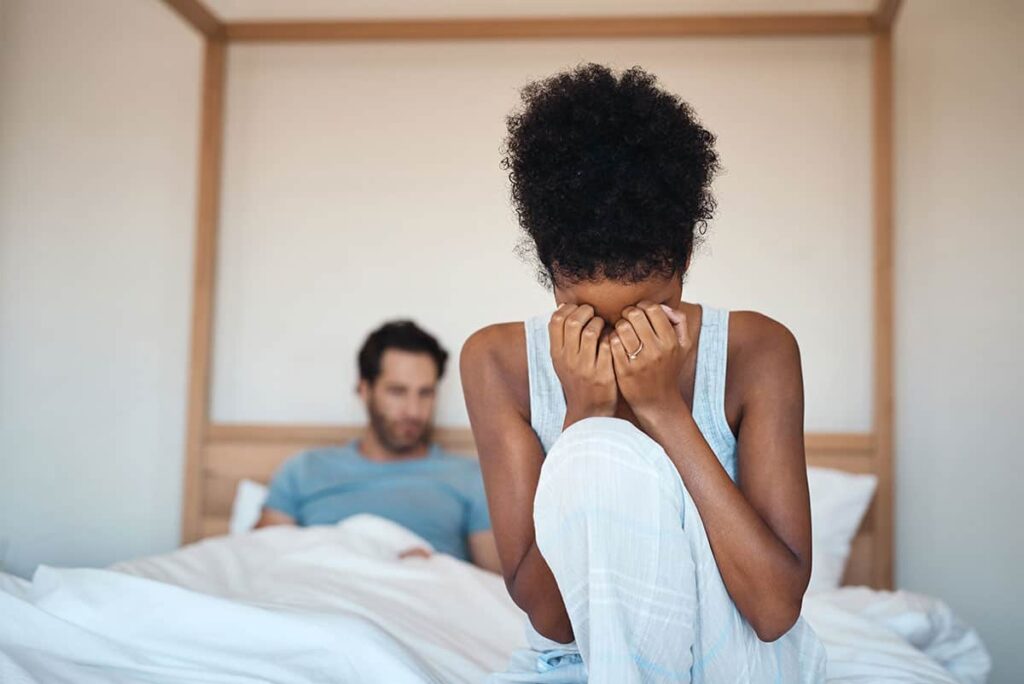Painful intercourse is far more common than many people realize, but it’s also widely misunderstood. For those experiencing discomfort during sex, it can feel isolating, confusing, and emotionally draining. While some may use the term “painful sex” as a catch-all, not all pain is the same. Two of the most common but often confused conditions are dyspareunia and vulvodynia. Though they may share some overlapping symptoms, they stem from different causes and require different approaches to diagnosis and treatment.
In this blog, we’ll explore the key differences between dyspareunia and vulvodynia, two conditions that are often grouped under the umbrella of painful intercourse but are actually quite distinct. We’ll also break down what each condition really means, their common causes, how they’re diagnosed, and why recognizing the difference is crucial for effective treatment.
What is Dyspareunia?

Dyspareunia refers to ongoing or recurrent pain during or after sexual intercourse. It’s a symptom rather than a standalone disease, and it can affect individuals of any age or gender, though it is most commonly experienced by women. The pain can be felt at the entrance of the vagina (superficial dyspareunia) or deeper within the pelvis (deep dyspareunia), and it may occur only during specific activities or persist throughout sexual activity. The sensation varies. Some describe it as sharp, burning, aching, or cramping.
There are many possible causes of dyspareunia, both physical and psychological. Physical causes can include vaginal dryness (often from hormonal changes like menopause), infections, injuries from childbirth, endometriosis, pelvic inflammatory disease, or issues with the pelvic floor muscles. Emotional and mental health factors like stress, anxiety, and past trauma can also contribute to or worsen the pain. Because these causes can overlap, pinpointing the root issue may take time and careful evaluation.
Recommended: Maintaining Intimacy When Intercourse Is Painful
Treating dyspareunia begins with understanding its source. For some, this might involve medical treatment such as antibiotics, hormone therapy, or physical therapy to relax tight pelvic floor muscles. For others, counseling or sex therapy can be incredibly helpful, especially if the pain is tied to emotional factors or past trauma. With the right support and treatment plan, many people find significant relief, proving that painful sex is not something anyone has to simply live with.
What is Vulvodynia?
Vulvodynia is a chronic pain condition that affects the vulva without an identifiable medical cause. Unlike dyspareunia, which may occur only during intercourse, vulvodynia pain can be constant or triggered by light touch, such as during sitting, wiping, or wearing tight clothing. The pain is often described as burning, stinging, rawness, or irritation and can last for months or even years, significantly impacting quality of life.
There are two main types of vulvodynia: provoked vulvodynia, where pain occurs only when the area is touched (e.g., during sex or tampon insertion), and unprovoked vulvodynia, where pain may be present even without physical contact. The exact cause is unknown, but potential contributing factors include nerve injury, hormonal changes, inflammation, muscle dysfunction, or genetic predisposition. Emotional distress, anxiety, and a history of trauma may also worsen the experience of pain.
Recommended: Provoked vs Unprovoked Vulvodynia: What’s the Difference?
Because there’s no visible sign of disease or infection, vulvodynia is often misunderstood or misdiagnosed, leading many sufferers to feel dismissed or hopeless. However, with the growing awareness of the condition, more treatment options are becoming available. These may include medications (like nerve pain reducers), pelvic floor physical therapy, cognitive-behavioral therapy, lifestyle changes, or even nerve blocks in severe cases. The key to managing vulvodynia lies in a personalized and multidisciplinary approach, offering hope and healing to those who have long lived in silent pain.
Key Differences Between Dyspareunia and Vulvodynia
While dyspareunia and vulvodynia both involve genital pain and can affect a person’s sexual health and well-being, they are not the same condition. Understanding their differences can help guide proper diagnosis, treatment, and emotional support. Here are the key ways they differ:
1. Location and Nature of Pain
- Dyspareunia refers specifically to pain during or after sexual intercourse. The pain can be superficial (at the vaginal entrance) or deep (within the pelvis).
- Vulvodynia involves chronic pain on the vulva that may not be connected to intercourse at all. It can be constant or triggered by simple activities like sitting, walking, or wearing tight clothes.
2. Triggers of Pain
- Dyspareunia is usually triggered by sexual activity, such as penetration or thrusting.
- Vulvodynia may occur spontaneously (unprovoked) or be triggered by any kind of pressure or touch (provoked), even outside of sexual contexts like inserting a tampon or touching the area with a towel.

3. Underlying Causes
- Dyspareunia often has identifiable causes such as infections, vaginal dryness, endometriosis, hormonal changes, or physical trauma.
- Vulvodynia does not have a clear medical cause, although it may be linked to nerve irritation, inflammation, or genetic factors. It is classified as a chronic pain condition.
Recommended: Is Burning During Penetration a Sign of Vaginismus?
4. Duration and Timing
- Dyspareunia pain usually occurs during or after intercourse and may go away afterward.
- Vulvodynia pain may be ongoing and persist even when the vulva isn’t being touched or stimulated, making daily life uncomfortable or even debilitating.
5. Diagnosis and Visibility
- Dyspareunia can sometimes be diagnosed through physical exams or tests that reveal underlying medical issues.
- Vulvodynia is often diagnosed after ruling out all other possible causes. The vulva may look completely normal despite intense pain.
6. Treatment Approaches
- Dyspareunia treatment targets the specific underlying cause, such as lubricants for dryness, antibiotics for infections, or hormone therapy.
- Vulvodynia usually requires a multidisciplinary approach, including nerve pain medication, physical therapy, lifestyle changes, and sometimes psychotherapy.
7. Emotional and Psychological Impact
- Both conditions can take a toll on emotional health, but vulvodynia, being chronic and often misunderstood, can lead to increased frustration, depression, and anxiety.
- Dyspareunia, especially when short-term or treatable, may have less psychological burden, but this varies from person to person.
How Doctors Diagnose Each Condition
Diagnosing dyspareunia and vulvodynia can be challenging because symptoms often overlap, and the causes aren’t always visible. However, healthcare professionals use different approaches depending on the type and pattern of pain described.
Recommended: Creating a Pain Management Plan for Chronic Sexual Pain
1. Detailed Medical History
Doctors begin by asking questions about the nature, location, and timing of the pain:
- When does the pain occur—only during intercourse or also with daily activities?
- Is the pain burning, stinging, aching, or sharp?
- Has there been a history of infections, trauma, surgery, childbirth, or sexual assault?
This step helps narrow down whether the symptoms are more consistent with dyspareunia or vulvodynia.
2. Pelvic and Physical Examination
- For dyspareunia, a pelvic exam can help identify possible physical causes such as vaginal dryness, infections, scars, or pelvic organ prolapse.
- For vulvodynia, the vulva may look completely normal, so a cotton swab test is often used. This involves gently pressing different areas of the vulva to identify pain sensitivity and whether the pain is provoked or unprovoked.
3. Lab Tests
Doctors may take swabs to check for:
- Yeast or bacterial infections
- Sexually transmitted infections (STIs)
- Vaginal pH levels
These help rule out treatable causes of pain.
4. Pelvic Floor Muscle Evaluation

Because muscle tightness or dysfunction can cause or worsen pain, doctors might assess the pelvic floor manually or refer patients to a pelvic floor physical therapist for further evaluation.
Recommended: How Living with a Chronic Sexual Condition Impacts Your Mental Health
5. Referral to Specialists
If the cause remains unclear or pain persists, patients may be referred to:
- A gynecologist with experience in sexual pain disorders
- A pain specialist
- A sex therapist or psychologist (especially when emotional trauma or anxiety may be contributing)
Early diagnosis is key, but sadly, many patients are dismissed or misdiagnosed. If you suspect either condition and feel unheard, don’t hesitate to seek a second opinion. Your pain is valid, and it deserves proper care.
Treatment Approaches for Dyspareunia vs. Vulvodynia
Because dyspareunia and vulvodynia stem from different causes, their treatments vary. Both conditions benefit from a personalized, multi-faceted approach. Below is a breakdown of common treatment strategies for each.
Treatment for Dyspareunia:
- Use of water-based or silicone-based lubricants can help reduce friction and ease vaginal dryness during intercourse.
- Topical estrogen therapy may be prescribed for postmenopausal women experiencing pain due to vaginal atrophy.
- Pelvic floor physical therapy can relieve pain caused by muscle tightness or pelvic floor dysfunction.
- Cognitive behavioral therapy (CBT) can address psychological factors such as anxiety or fear related to sex.
- Treating underlying infections with appropriate antibiotics or antifungals is essential when pain is caused by conditions like yeast infections or bacterial vaginosis.
Recommended: Can You Have Vaginismus Without a History of Trauma?
Treatment for Vulvodynia:
- Topical anesthetics like lidocaine ointment can be applied to numb the vulvar area and reduce pain during daily activities or intercourse.
- Oral medications such as tricyclic antidepressants (e.g., amitriptyline) or anticonvulsants (e.g., gabapentin) may help decrease nerve-related pain.
- Pelvic floor physical therapy can relieve muscle tension and improve pelvic support, which often contributes to vulvodynia.
- Cognitive behavioral therapy (CBT) or sex therapy can address the emotional and psychological effects of chronic vulvar pain.
- In severe or localized cases, surgical removal of painful tissue (vestibulectomy) may be considered if other treatments have failed.
Conclusion
Painful intercourse is not something anyone should ignore—or feel ashamed to talk about. While dyspareunia and vulvodynia may seem similar on the surface, they are distinct conditions with different causes, symptoms, and treatments. Understanding the differences is the first step toward getting an accurate diagnosis and finding the right support.
Whether the pain is physical, emotional, or both, it is real—and manageable. With the right medical care, open communication, and a willingness to advocate for yourself, healing is possible. No one should suffer in silence. If you’re experiencing pain during sex or in your daily life, reach out to a healthcare professional who listens, believes you, and is committed to helping you feel whole again.
